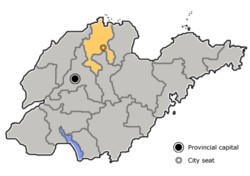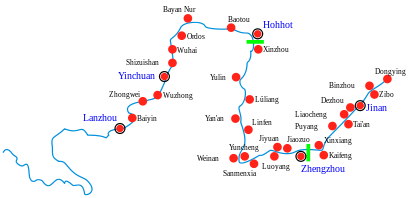Binzhou
Binzhou
滨州 | |
|---|---|
| 滨州 | |
 | |
| Country | People's Republic of China |
| Province | Shandong |
| County-level divisions | 7 |
| City seat | Bincheng District (37°22′N 118°0′E / 37.367°N 118.000°E) |
| Government | |
| • CPC Secretary | Sun Dehan (孙德汉) |
| • Mayor | An Shiyin ( |
| Area | |
| • Total | 9,444.65 km2 (3,646.60 sq mi) |
| Population | |
| • Total | 3,661,500 |
| • Density | 390/km2 (1,000/sq mi) |
| Time zone | UTC+8 (China Standard) |
| Area code | 543 |
| License Plate Prefix | 鲁M |
Binzhou (simplified Chinese: 滨州; traditional Chinese:
Humans have been living in the area around Binzhou since the Neolithic era. It was called “Pugu country” in the Shang Dynasty, and was a county in the Qin Dynasty. It was first called Binzhou in era of the Five Dynasties because it borders the Bohai Sea. Nowadays, it has more than 3.7 million inhabitants. The major Industries are based on oil, chemicals and textiles.
Administration
The prefecture-level city of Binzhou administers 7 county-level divisions, including 1 district and 6 counties.
- Bincheng District (滨城
区 ) - Zouping County (邹平县)
- Boxing County (
博 兴县) - Huimin County (
惠 民 县) - Yangxin County (阳信县)
- Zhanhua County (沾化县)
- Wudi County (无棣县)
Prior to 1983, both Binzhou and neighboring Dongying were not considered large or developed enough to be incorporated into cities. Instead, they formed a "di qu" (literally, a "region") managed by the provincial government. BinZhou used to be named Huimin Prefecture (
Climate
Binzhou has a monsoon-influenced humid continental climate (Köppen Dwa), with four well-defined seasons. Conditions are warm and nearly rainless in spring, hot and humid in summer, crisp in autumn and cold and dry in winter. More than half of the annual precipitation occurs in July and August alone; snow occasionally falls during winter, though heavy falls are very rare.
| Climate data for Binzhou (1971−2000) | |||||||||||||
|---|---|---|---|---|---|---|---|---|---|---|---|---|---|
| Month | Jan | Feb | Mar | Apr | May | Jun | Jul | Aug | Sep | Oct | Nov | Dec | Year |
| Mean daily maximum °C (°F) | 2.7 (36.9) |
5.8 (42.4) |
12.2 (54.0) |
20.5 (68.9) |
26.1 (79.0) |
30.8 (87.4) |
31.3 (88.3) |
30.0 (86.0) |
26.3 (79.3) |
20.3 (68.5) |
11.8 (53.2) |
4.8 (40.6) |
18.6 (65.5) |
| Mean daily minimum °C (°F) | −7.8 (18.0) |
−5.4 (22.3) |
0.4 (32.7) |
7.8 (46.0) |
13.6 (56.5) |
18.8 (65.8) |
22.2 (72.0) |
21.1 (70.0) |
15.1 (59.2) |
8.5 (47.3) |
0.7 (33.3) |
−5.2 (22.6) |
7.5 (45.5) |
| Average precipitation mm (inches) | 4.2 (0.17) |
7.7 (0.30) |
10.1 (0.40) |
23.1 (0.91) |
39.3 (1.55) |
70.3 (2.77) |
184.3 (7.26) |
135.4 (5.33) |
44.0 (1.73) |
31.9 (1.26) |
13.5 (0.53) |
4.8 (0.19) |
568.6 (22.4) |
| Average precipitation days (≥ 0.1 mm) | 2.2 | 2.8 | 3.6 | 5.1 | 5.6 | 7.3 | 12.3 | 9.4 | 6.2 | 4.9 | 4.1 | 2.4 | 65.9 |
| Source: Weather China | |||||||||||||
Transportation
Education
Notable people
- Sun Tzu, Spring and Autumn era military general and strategist, author of the Art of War.
Economy
Binzhou, and neighboring Dongying, has historically had an agrarian economy. Binzhou is known regionally for its "dongzao" (literally, winter dates). After the Shengli Field was discovered, most of the field was incorporated into newly created Dongying, although Binzhou maintain some oil operations. Binzhou has been diversifying its economy away from agriculture by attracting manufacturing and foreign direct investment into the city. Among Binzhou's large businesses include Weiqiao, a textile company, and Binzhou Pride, a new auto company targeting the growing low-cost market. [1] [2]
The Binzhou local government has also plowed resources into a new economic development zone on the outskirts of the new city, complete with a man-made lake. [3]
Binzhou's role in pet food crisis
In April 2007, Binzhou made international headlines when Binzhou Futian Biology Technology, in Wudi County, was identified by US officials as one of two sources of contaminated wheat gluten in the 2007 pet food recalls. Shortly after, the company was shuttered by Chinese authorities, who also detained its general manager.[1]
Reform
In 2004, the Binzhou government implemented Democratic Political Discussion Day, held on the 5th of each month. Under this scheme, every village-level government on this day is required to hold "open debate" and conference for villagers (essentially a town hall). At these meetings, a monthly financial report is presented, highlighting past and planned expenditure, investment performance and such other financial information. In theory, this is supposed to open village finances to greater public scrutiny and debate. Also released at these meetings are reports on the past performance of the government and governmental officials, and future actions and decisions planned, and just like the financial reports, these are also under the public scrutiny and debate. The resulting event is a secret ballot for every villager to vote for everything discussed at these meetings and governments cannot proceed on any issues unless they are passed with a majority vote. The issues passed by popular vote would then be carried out, and at the same time, the government would also make improvement and adjustment on the policies and issues that did not pass, and then present the revisions for the public scrutiny and debate at the next meeting.
Result of the political reform
Ever since the implementation of the political reform at Binzhou, the policy and performance have become transparent and obvious, corruption was checked, cadres' performance and popular support increased, and economy has steadily developed. The letters of petition from villagers to the government reduced more than 30%, and more importantly, in comparison to the era prior to the implementation of the political reform where over 90% of the petitions were criticism and complaints, over 90% of the petition after the implementation of the political reform was suggestions for improvement and requests for assistance.
The obvious achievement of the political reform of Binzhou is widely reported in the domestic Chinese media, as well as many overseas Chinese media, such as Zhong Guo Daily News in Southern California, or its more commonly known Chinese name among local Chinese readers, China Daily (Not to be confused China Daily, the official English publication of Chinese government), and is termed by both domestic and overseas scholars as a good example for governments in other parts of China to follow, and along with Chinese media, they have urged authorities to slowly but steadily expand the reform to a greater scale.
City gallery
-
The center lake of Binzhou (2009)
-
It is one of summer evening public performs of Binzhou (2009)
-
Old people do Taiji in community(2009)
-
A floral insculp in park (2010)
-
A special food called Guozibing in Binzhou (2010)
-
Evening (2010)
-
A succulent sweet fruit (2010)
-
A residential development in the new part of the city (2006)
-
A random giant giraffe display in an old apartment complex (2006)
References
- ^ David Barboza (June 5, 2007). "When Fakery Turns Fatal". The New York Times. Retrieved 2007-06-22.








